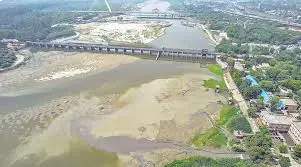30-point action plan, 6 agencies: How the Centre plans to clean up the Yamuna

The Centre, in collaboration with the Delhi government, has rolled out an ambitious 30-point action plan aimed at cleaning the Yamuna River, a project that involves six agencies working together to address pollution and improve the river’s health. The primary goal is to bring the Yamuna back to bathing standards by 2027, making it a cleaner and safer water source.
Key Agencies Involved
- Ministry of Jal Shakti – This federal body will coordinate the overall national water policy and ensure seamless collaboration between different agencies.
- Delhi Jal Board (DJB) – DJB is tasked with overseeing the city’s water supply and sewage systems.
- Delhi Development Authority (DDA) – Responsible for planning and urban development along the river.
- Central Pollution Control Board (CPCB) – CPCB will monitor pollution levels and enforce environmental laws.
- Delhi Pollution Control Committee (DPCC) – The DPCC will ensure local enforcement of pollution control measures.
- Municipal Corporation of Delhi (MCD) – MCD will handle waste management and sanitation issues within the city.
The 30-Point Action Plan: Major Components
1. Strengthening Sewage Treatment Systems
- Expansion of Sewage Treatment Plants (STPs): Upgrading and expanding STPs to treat more sewage, with a target to treat 750–800 MGD (million gallons per day), up from the current 600 MGD.
- On-Site Drain Treatment: Implementing decentralized treatment solutions for key drains to minimize untreated sewage from entering the river.
- Network Upgrades: Rehabilitating old sewer systems, enhancing their capacity, and improving waste water collection infrastructure.
2. Industrial Pollution Control
- Upgrading Effluent Treatment Plants (ETPs): Modernizing industrial effluent treatment facilities to manage waste more effectively.
- Action Against Polluting Industries: Strict action against industries that continue to pollute the river with untreated effluents, including shutting down non-compliant operations.
3. Improving Sanitation for Communities
- Sewer Connections for Slums: Connecting underserved areas like slums and informal settlements to the main sewage network to eliminate open defecation.
- Household Sewer Connections: Ensuring proper household connections to the sewer network, ensuring that waste is disposed of safely.
4. Pollution Monitoring and Enforcement
- Real-Time Water Quality Monitoring: Installing monitoring stations along the Yamuna to continuously measure water quality, enabling swift responses to pollution spikes.
- Stronger Regulatory Oversight: Regular inspections of industries, with penalties for those violating environmental standards.
5. Public Awareness and Community Involvement
- Educational Initiatives: Running campaigns to raise public awareness about the importance of keeping the Yamuna clean.
- Community-Driven Initiatives: Encouraging local communities to participate in cleaning drives and regular river monitoring activities.
6. Revitalization and Riverfront Development
- Creating Riverfront Spaces: Developing spaces along the river for recreation, tourism, and community engagement.
- Eco-Friendly Water Transport: Introducing sustainable water transport systems, like water taxis, to reduce the burden on road traffic and minimize pollution.
Financial and Technical Support
- Budget Allocation: The Delhi government has committed ₹1,500 crore for the project, with additional support expected from the Centre to meet international standards.
- Technological Integration: Modern technologies will be integrated into sewage treatment, waste management, and monitoring systems for greater efficiency.
Timeline for Implementation
- Short-Term (2025–2026): Focus on infrastructure upgrades, such as expanding STPs, treating drains, and connecting slums to the sewer system.
- Medium-Term (2026–2027): Public awareness campaigns, pollution monitoring, and development of riverfront areas.
- Long-Term (Post-2027): Achieving a clean and sustainable river, with improved health and water quality for long-term use.
This 30-point action plan marks a major milestone in the Centre and Delhi government’s efforts to restore the Yamuna. Through coordinated efforts and clear timelines, the goal is to return the river to a state where it serves as a vital resource for the people while preserving its ecological health.






